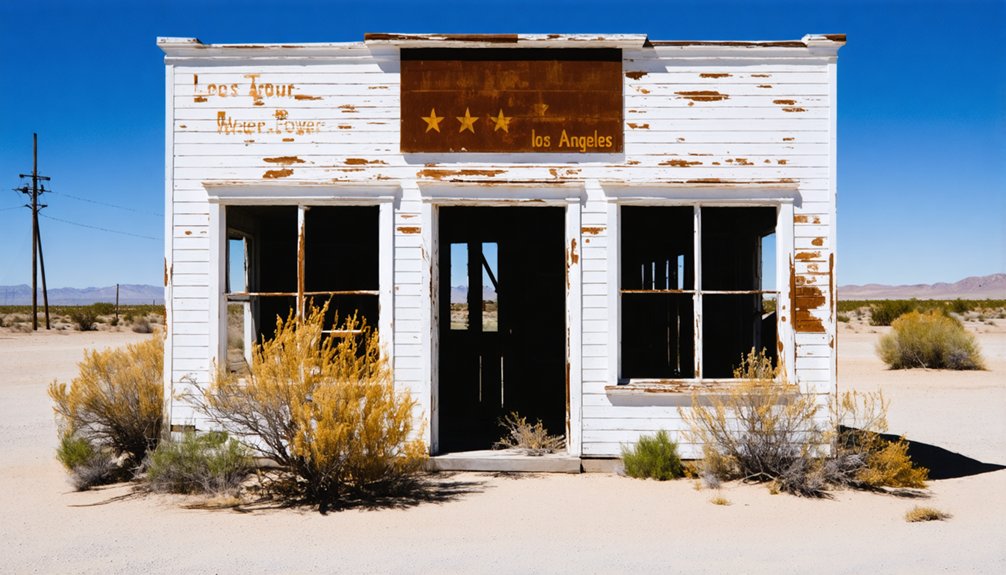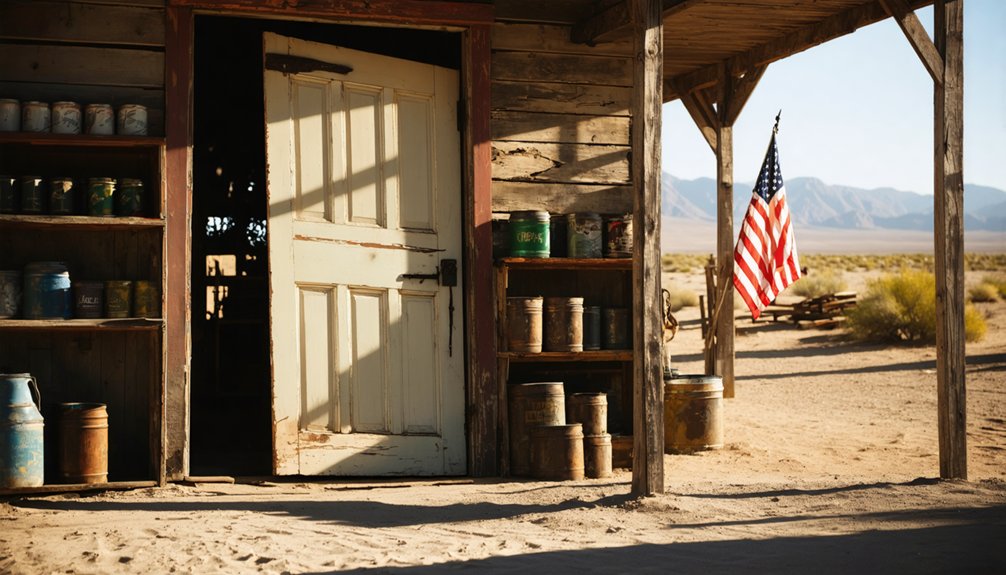Intake emerged in the late 1800s as a supply point along California’s Sierra Nevada range, supporting mining operations and water management during the Gold Rush era. You’ll find remnants of the town’s rich mining history, including abandoned tunnel systems and equipment that once processed millions in gold. Daily life revolved around mining shifts, community gatherings, and diverse social establishments. The town declined due to resource depletion, fires, and harsh geography, leaving fascinating archaeological remnants that tell a compelling frontier story.
Key Takeaways
- Intake emerged in the late 1800s as a water management settlement during California’s Gold Rush era.
- The town supported mining operations with hydraulic techniques that extracted gold from placer deposits.
- Daily life centered around mining shifts, with businesses like saloons and general stores serving the community.
- Resource depletion, devastating fires, and harsh climate conditions eventually led to the town’s abandonment.
- Archaeological remains include over 400 homes, public facilities, and mining equipment that showcase mid-20th century industrial heritage.
Historical Origins of Intake
While largely forgotten in the annals of California’s boom-and-bust mining history, Intake emerged in the late 1800s as a small but essential outpost along the eastern Sierra Nevada range.
This ghost town originated as a supply point for local mining operations, strategically positioned to control water resources critical to both mining and agricultural endeavors in the region.
Unlike more famous abandoned settlements, Intake’s historical significance lies in its specialized function rather than size.
You’ll find that its founding coincided with the expansion of industrial mining techniques that demanded increased water management infrastructure. The town experienced a similar fate to Eagle Mountain, where harsh desert conditions accelerated the deterioration of abandoned structures. Like Bodie State Park, Intake eventually succumbed to economic decline as mining opportunities shifted elsewhere. The town’s name directly reflects its primary purpose—serving as an intake point for water diversion systems that powered regional development.
The settlement expanded gradually as operations intensified, attracting a small but dedicated population of workers and support services.
Mining Operations and Economic Development
You’ll find Intake’s origins directly tied to the California gold rush, when prospectors established the Big Bend Mining Co. to extract promising ore deposits from the hillsides.
The initial high-grade ore fueled economic optimism, creating a brief period of prosperity that supported local businesses and attracted labor to this remote location. Like many mining operations during the rush, Intake’s miners eventually transitioned from simple panning to more complex placer mining techniques as surface gold diminished. The development of banking systems like Wells Fargo in 1852 facilitated financial transactions for mining operations throughout California’s gold country.
Quality of the extracted ore gradually declined, however, as miners exhausted the richest veins and faced increasing challenges with deeper, lower-yield deposits.
Gold Rush Beginnings
As the California Gold Rush gained momentum in the mid-19th century, Intake emerged as a significant mining settlement, capitalizing on the rich placer gold deposits embedded in ancient river gravels.
You’d find miners quickly adopting hydraulic techniques by the mid-1850s, using powerful water cannons to blast away hillsides and expose gold-bearing materials. This destructive practice created extreme environmental damage, with 1.5 billion cubic yards of sediment washed away during the Gold Rush era.
These placer mining operations weren’t small endeavors—they transformed the landscape while extracting millions in gold value. The rapidly growing industry attracted over a quarter million people to California, dramatically reshaping the demographic landscape.
Mining companies engineered extensive tunnel systems and drainage networks to maximize recovery efficiency. The slurry would flow through sluices equipped with mechanical riffles where mercury amalgamation captured even the finest gold particles.
This technological innovation allowed for processing previously unworkable deposits, fueling Intake’s rapid growth and contributing to Northern California’s explosive economic development during this transformative period.
Declining Ore Quality
Despite the initial prosperity fueled by gold extraction, Intake’s mining operations faced a critical turning point when ore grades began their inevitable decline following the mid-19th century boom.
You’d have witnessed mining companies confronting deeper shafts, increased pumping costs, and diminishing returns as rich deposits gave way to less concentrated ore bodies.
The economic impacts rippled throughout the community as declining production forced smaller operations to shutter.
Larger companies consolidated control, implementing cost-cutting measures rather than expansion.
You’d have seen employment opportunities shrink as labor-intensive methods yielded to mechanization—a necessary response to thinning profit margins.
Infrastructure investments dried up, leaving the town’s facilities deteriorating.
Similar challenges affected the Cardinal Mine operations, which eventually closed despite significant gold production and extensive tunneling infrastructure.
The mine shafts filled with water after closure, much like those at the Empire Mine in Grass Valley which contained 367 miles of tunnels.
Intake’s transformation from bustling mining center to ghost town exemplifies how resource-dependent communities collapse when technological advances can’t overcome the fundamental challenge of depleted resources.
Life in Intake During Its Heyday
Life in Intake during its golden era centered around the demanding rhythm of mining shifts, with miners working grueling hours while supporting businesses thrived on their hard-earned wages.
You’d find the town buzzing with activity as saloons, general stores, and boarding houses served a diverse population that included fortune-seekers, entrepreneurs, and families who built rudimentary community institutions despite harsh living conditions. Similar to Bodie’s population which reached nearly 10,000 residents during its peak, Intake attracted masses hoping to strike it rich during California’s mining boom.
The cultural landscape reflected California’s mining-era diversity, featuring frequent social gatherings amid the ever-present tension between opportunity and lawlessness that characterized frontier settlements. Like many other California ghost towns, Intake experienced the typical boom and bust cycle when resources eventually depleted and dreams faded.
Mining Economy and Labor
While most California ghost towns share similar economic trajectories, Intake’s mining economy operated within a particularly volatile framework of precious metal extraction that defined both its meteoric rise and inevitable decline.
You’d have found miners descending into treacherous shafts reaching depths beyond 1,800 feet, facing daily perils from collapse and toxic fumes.
The town’s labor practices mirrored the harsh realities of 19th-century mining—skilled workers managed stamp mills where mercury amalgamation and cyanide processes extracted gold, while immigrant and child laborers filled unskilled positions.
Economic fluctuations dictated everything; when metal prices plummeted, mines closed abruptly. Workers often migrated between towns, following opportunity across the Sierra Nevada range, living in boarding houses and seeking brief respite in local saloons after punishing shifts.
Daily Community Activities
Beyond the ore extraction that defined Intake’s economic foundation, a vibrant tapestry of daily routines shaped community identity during the town’s prosperous years. You’d find yourself frequenting the general store not just for necessities but for news and conversation.
Water collection from nearby springs became a communal activity, while sanitation relied on strategically placed outhouses.
Community gatherings centered around the wooden church, where Sunday services provided spiritual and social sustenance. During paydays, you’d anticipate traveling merchants bringing luxury items unavailable locally.
Daily routines followed seasonal patterns—summer focused on mining and construction, winter on maintenance and indoor activities.
When seeking entertainment, you’d join neighbors at the saloon for card games or attend occasional community dances.
Children’s education happened in single-room schoolhouses, where multi-aged groups learned basic skills essential for frontier life.
Cultural and Social Life
During Intake’s heyday, social dynamics mirrored those of larger California boom towns, with the population structure exhibiting both stratification and fluidity characteristic of mining communities.
You’d find distinct social hierarchies forming around economic function and ethnicity, with separate Chinese districts and notorious red-light areas marking the town’s boundaries.
Community gatherings centered primarily in the town’s numerous saloons—social hubs where miners exchanged stories and settled disputes, often violently.
These establishments, numbering up to 65 in similar towns like Bodie, provided essential recreational outlets in a harsh frontier existence.
Newspapers connected residents to local happenings while documenting the frequent gunfights and conflicts that characterized daily life.
Despite the lawlessness, mining celebrations and social clubs offered rare moments of communal cohesion in a town where most residents remained transient, their fortunes tied to the fluctuating prosperity of the mines.
Factors Leading to Abandonment

The gradual unraveling of Intake as a thriving settlement occurred through a complex interplay of economic, environmental, and social factors that ultimately rendered the town uninhabitable.
Resource depletion struck first, as miners exhausted the area’s precious metals, leaving operations unprofitable and triggering economic collapse. When the mines closed, residents fled to more promising boomtowns or agricultural regions.
Intake’s remote geography and harsh climate compounded these problems. Limited water access and poor soil prevented agricultural alternatives, while brutal winters isolated the community from essential supply routes.
Devastating fires destroyed critical infrastructure, making rebuilding economically unfeasible. Legal restrictions on land ownership further discouraged potential settlers from investing in the area’s future, sealing Intake’s fate as another California ghost town.
Remaining Structures and Archaeological Significance
Ghostly remnants of a once-thriving industrial community dominate Intake’s landscape today, offering archaeologists and historians a remarkably intact portrait of mid-20th century company town life.
Over 400 homes stand in eerie grid formations, accompanied by public amenities like schools, churches, and recreational facilities—all surrendering slowly to desert elements.
You’ll find historical artifacts scattered throughout these abandoned spaces: furniture, personal items, and sports trophies suggesting hasty departure.
The remaining architecture reveals the town’s industrial heritage through rusted mining equipment and deteriorating refineries. These structures represent more than decay; they’re tangible connections to California’s resource extraction economy and labor history.
Particularly significant is evidence of the early healthcare system that eventually evolved into Kaiser Permanente, making Intake an invaluable time capsule of American industrial development and its subsequent abandonment.
Visiting Intake: Directions and Preservation Efforts

Venturing to Intake requires careful navigation through California’s eastern Sierra region, where this lesser-known ghost town awaits intrepid explorers willing to venture beyond well-trodden paths.
From Bishop, follow Highway 395 north, though you’ll need detailed coordinates as this site lacks established infrastructure. Ghost town access varies seasonally, with unpaved roads potentially requiring high-clearance vehicles.
For ideal visitor preparation:
- Bring sufficient water, supplies, and offline navigation tools
- Inform others of your travel plans due to limited cell service
- Respect historical integrity by avoiding artifact disturbance
- Consider combining your journey with visits to nearby preserved sites like Bodie
Unlike formally protected locations, Intake lacks staffed preservation programs, highlighting your responsibility in maintaining this unregulated slice of California’s mining history.
Frequently Asked Questions
Are There Any Paranormal Activities Reported in Intake?
You’ll find limited documented ghost sightings in Intake compared to neighboring haunted locations, though regional paranormal patterns suggest potential undocumented phenomena similar to other California ghost towns with tragic histories.
What Indigenous Tribes Originally Inhabited the Intake Area?
Where whispers of history fade into silence, you’ll find tribal history obscured. No specific records document which indigenous culture inhabited Intake area, requiring deeper archaeological and anthropological investigation.
Did Any Famous Historical Figures Visit Intake?
You’ll find no documented famous visitors to Intake. Its historical significance remains largely unrecorded, lacking verified accounts of notable figures traversing this lesser-known California location.
Were Movies or Television Shows Ever Filmed in Intake?
Like a forgotten page torn from Hollywood’s script, no documented evidence shows Intake ever served as a film location. Your search for ghost stories captured on camera here yields only historical emptiness.
What Natural Disasters Affected Intake’s Development?
You’d find Intake’s development severely hindered by earthquake impacts that damaged mining infrastructure and flood aftermath that repeatedly destroyed buildings, transportation routes, and equipment—both contributing considerably to its economic decline and eventual abandonment.
References
- https://www.flyingdawnmarie.com/new-blog/bodie-ghost-town
- https://www.camp-california.com/california-ghost-towns/
- https://www.youtube.com/watch?v=OD9M6MP6RRU
- https://amadorgold.net/tours/ghosttowns/aqueduct/index.html
- https://www.visitcalifornia.com/road-trips/ghost-towns/
- https://www.californist.com/articles/interesting-california-ghost-towns
- https://dornsife.usc.edu/magazine/echoes-in-the-dust/
- https://www.youtube.com/watch?v=ElbXVNDurPc
- https://www.photopilot.com/blog/eagle-mountain-california/
- https://www.youtube.com/watch?v=zdJ6-uq2XBo



